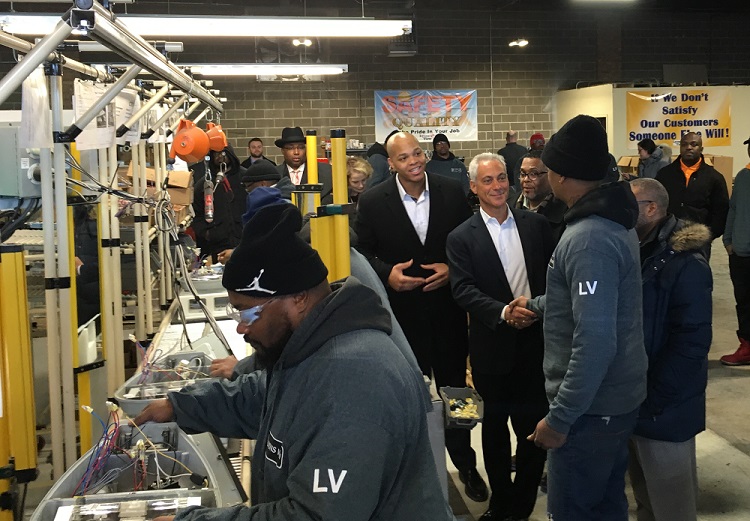Mayor Emanuel Highlights Progress Achieved by City of Chicago’s Historic Streetlight Modernization Program
CDOT has Installed More Than 18,000 New LED Streetlights on South and West Side Streets; Mayor Tours West Side Assembly Plant Supporting Project to Modernize 270,000 Lights Over Four Years

With more than 18,000 new streetlights installed on the south and west sides of the city, Mayor Rahm Emanuel today announced that the Chicago Smart Lighting Program is now expanding to residential streets, beginning on the west side. The state-of-the-art new system is designed to provide clear and reliable lighting in every Chicago neighborhood.
“The Chicago Smart Lighting Program is off to a great start, delivering modern, reliable, energy-efficient lighting that is already improving quality of life in Chicago neighborhoods,” Mayor Emanuel said. "The new state-of-the-art smart lighting management system will automatically notify us when lights need to be serviced, addressing one of the top reasons people call 311. This program is a great example of how we are building a new Chicago for the 21st Century."
The Mayor appeared today at the Lyons View streetlight plant on W. Harrison where more than half of the lights used in the program’s first year are being assembled.
The Chicago Smart Lighting Program is being implemented by the Chicago Department of Transportation (CDOT). It will replace 270,000 of Chicago’s street, alley and viaduct lights with high-quality LED fixtures over the next four years. While other cities have typically replaced their street lights and subsequently added a lighting management system, Chicago is installing a smart lighting system as it replaces the outdated high-pressure sodium (HPS) lights. When it becomes operational later this year, the system will alert the City when lights need service.
The initial streetlight fixture replacements have been focused in neighborhoods on the south and west sides with heightened public safety concerns, allowing communities in the greatest need to most quickly reap the benefits of clearer and more reliable lighting.
With the work on West Side arterial routes expected to be complete this month, crews will begin switching out lights on West Side residential streets next, then shift to the South Side residential streets. The City plans to also install new light fixtures on more than a dozen main arterial routes throughout Chicago by the middle of 2018. The project will also include targeted repairs to poles and wiring to extend the life of existing infrastructure.
The City has created a website ( http://chicagosmartlighting.org) where Chicagoans can track the progress of the program.
The new lights, which are owned and operated by the City, will consume 50-75 percent less electricity than HPS lights, generating significant electricity cost savings that will offset the cost of the modernization. LED fixtures also last two-to-three times longer than HPS lights.
The program was procured by the Chicago Infrastructure Trust (CIT) in coordination with CDOT and the Department of Innovation and Technology (DoIT). The CIT is dedicated to assisting the City in executing large-scale and complex public projects efficiently and economically.
“This project demonstrates how the expertise of the CIT can be leveraged to make infrastructure investments that provide a maximum return for City residents and improve the quality of life in Chicago’s neighborhoods,” Chicago Treasurer and CIT Chair Kurt Summers said. “Through modernizing our infrastructure, the city will save money over the long term by lowering energy costs, vastly improving the lighting on our streets and alleys, and making our neighborhoods safer. We look forward to continuing our work on initiatives that will create equitable economic development in our neighborhoods in the years to come.”
“We are very pleased by the progress we’ve made in the first-year roll out of the program,” CDOT Commissioner Rebekah Scheinfeld said. “We have received positive feedback about the new lights. Residents are noticing that LED lights provide better nighttime visibility, and the LED light fixtures project light downward where it is needed on streets and sidewalks, not into the night sky.”
“Integrating connected technologies with the new LED lights provides Chicago with a smart lighting grid that will automatically identify issues and improve the level of service the City is providing to our residents,” DoIT Commissioner Danielle DuMerer said. “Energy and performance data collected by the lighting management system will also enable the City to better target future infrastructure investments."
The City of Chicago has contracted with a team led by Ameresco Inc., a national leader in the field of energy efficiency and renewable energy projects, to implement the program.
The City made it a priority to ensure that the selected vendor relies on a diverse lineup of subcontractors and that City residents will have access to the jobs created through the Smart Lighting Project.
The Lyons View assembly plant on the West Side delivers on this commitment. In addition, Ameresco set a goal of using at least 50 percent City residents on the project and has exceeded the goal to date, with more than 62 percent of the workers being Chicago residents.
